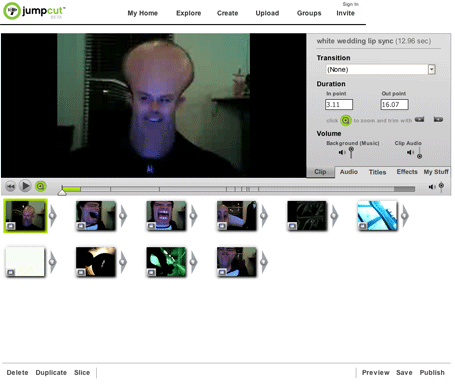No sooner did I proclaim Motionbox the best online video sharing service (mostly for its editing and deep tagging tools), than a new contender arrives on the scene. San Francisco based stealth startup Jumpcut, founded by Mike Folgner and Ryan Cunningham, just launched minutes ago.
In my mind there are now two distinct types of video sharing services. The first is the YouTube crowd and its dozens of clones, which allow easy uploading of files which are then transcoded into flash, and tagging of those files. The goal is to get video and page views, and it’s working.
It’s working so well, in fact, that it raises questions on their business model. YouTube is free but has very real bandwidth costs from showing these videos. They are dealing with this in two ways – by degrading the quality of the flash video files to reduce file size, and by raising another $8m from Sequoia, raising the total to $11.5 million.
The second group does what YouTube does, but also has some basic editing features. Included in this group is Grouper, Motionbox, Jumpcut and, to some extent, YouTube. Grouper and VideoEgg require a client download to use the service. Motionbox and Jumpcut don’t, although Jumpcut says they’ll have one as an option soon. With these last two, the editing occurs online, and therefore facilitates editing by a group on a shared video.
Jumpcut, as the newest entrant, has some really spectacular features, that should encourage video mashing between users. It’s editing features, also using Flash, are better than what I saw with Motionbox. Any video can be cloned (unless restricted by the publisher), and other clips can be added to the cloned video. Sound files can be added to either overwrite existing audio or mix in with it. They also allow a number of “transition” features as effects. Overall, its pretty cool. Check it out by clicking “remix” on this video screen.
Like YouTube, finished videos can be kept private, shared or made public. Jumpcuts provides code snippets to allow video playback from blogs and other websites as well. Unlike Motionbox, Jumpcut does not have a deep tagging feature, although Mike Folger says it is being built and that “it’s fairly straightforward using the Flash development tools”.
The service is currently free and allows uploads of up to 50 MB (YouTube allows 100MB). A paid service will be available soon in the $5/month range, and Jumpcut will also have a client install available to allow users to do some of the editing and transcoding work before uploading it to the Jumpcut server.
Overall, the service is eerily similar to Motionbox. Jumpcut has slightly better editing features, and Motionbox’s deep tagging is a definite feature win. Both of these services will be very useful for creating a single video from a group event where lots of different people are recording video – a wedding, for example. Jumpcut has angel funding by Westlake Venture Partners and Great Oaks Capital.
